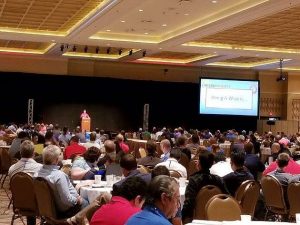
In October, the CBRS Alliance, Wireless Innovation Forum (WInnForum) and WISPA came together at WISPAPALOOZA to present a full-day master seminar highlighting the benefits of utilizing shared spectrum in the Citizens Broadband Radio Service (CBRS) 3.5 GHz band for wireless Internet service providers. We had more than 150 attendees participate our event, and it soon became apparent that there is a clear and present interest from WISPs in taking advantage of CBRS and shared spectrum. This was a rare opportunity for WISPs to take a deep dive into these technologies and learn more about the CBRS ecosystem and the growing opportunities available to customers in rural America.
Both the CBRS Alliance and WInnForum are at the forefront of creating the commercial standards and protocols for CBRS, and WISPA is working directly with key stakeholders in the band. Many WISPs currently hold licenses in the 3.65 GHz range, making them the perfect candidates to expand their services in the 3.5 GHz – 3.7 GHz CBRS band. At our event alone, more than 50 attendees indicated that they were currently licensed and operating in the 3.65 GHz band and were interested in upgrading to CBRS. For some, it would only necessitate a small software upgrade on their end to allow them to operate in CBRS.
There are more than 23.4 million consumers based in rural areas throughout the U.S. Many of these rural regions lack the coverage and capacity to deliver 10/1 Mbps fixed broadband to residents due to the state of local infrastructure. WISPs specialize in servicing these rural and exurban consumers, and with the release of the Connect America Fund, these providers could potentially be subsidized for moving into the CBRS band and providing broadband coverage to rural America.
A key concern for WISPs and their customers is cost. During the event, industry analyst Monica Paolini conducted a presentation that explored the financial benefits of CBRS for WISPs. Her research found that CBRS is a cost-effective opportunity for WISPs to get access to more spectrum and offer new services, with good propagation and better protection from interference. Monica will soon be releasing a full-length report on CBRS for fixed wireless use cases, so stay tuned for more details on that before the end of the year.
This event was the first time the CBRS Alliance, WInnForum and WISPA were able to come together and advocate for this new approach to spectrum sharing. The CBRS Alliance recently announced formal partnerships with both WInnForum and WISPA, and the groups plan to continue their work to establish a thriving ecosystem focused on commercializing the 3.5 GHz CBRS Band. By the first half of 2018, CBRS will make as much as 150 MHz of accessible new spectrum, and the opportunities and use cases for shared spectrum continue to multiply.
Want to learn more about CBRS? Connect with us on Twitter and LinkedIn to stay up to date on all the exciting work we’re doing, or drop us a line at info@cbrsalliance.org.

